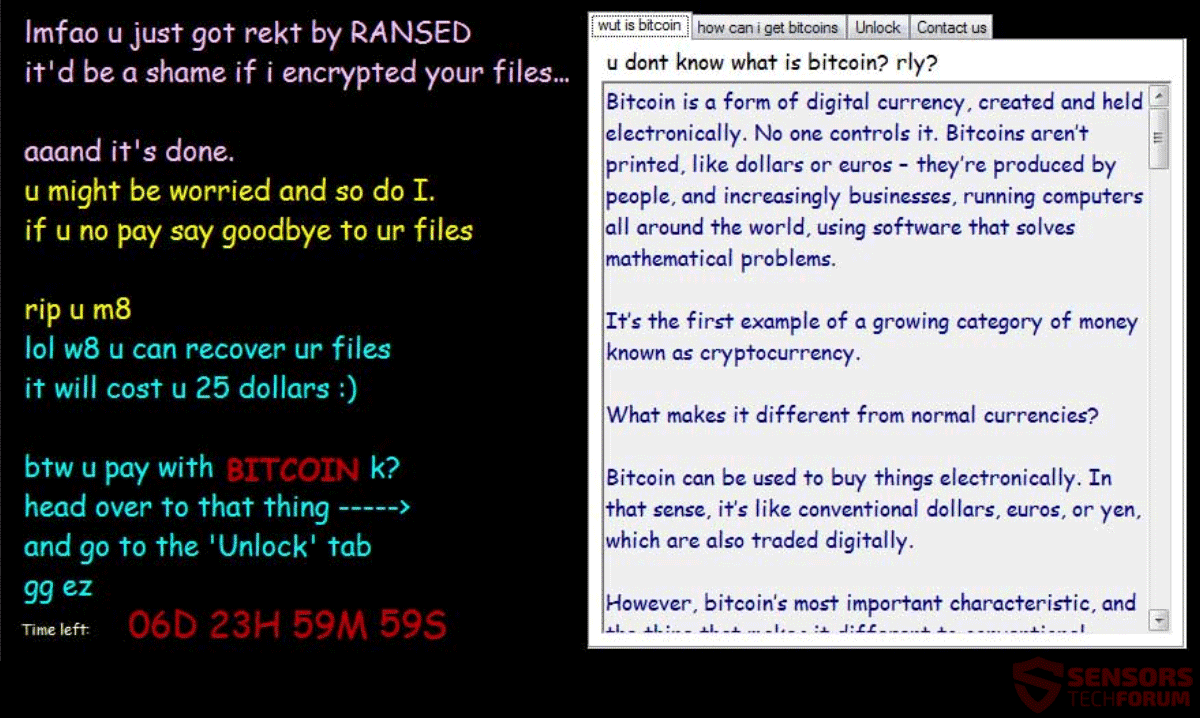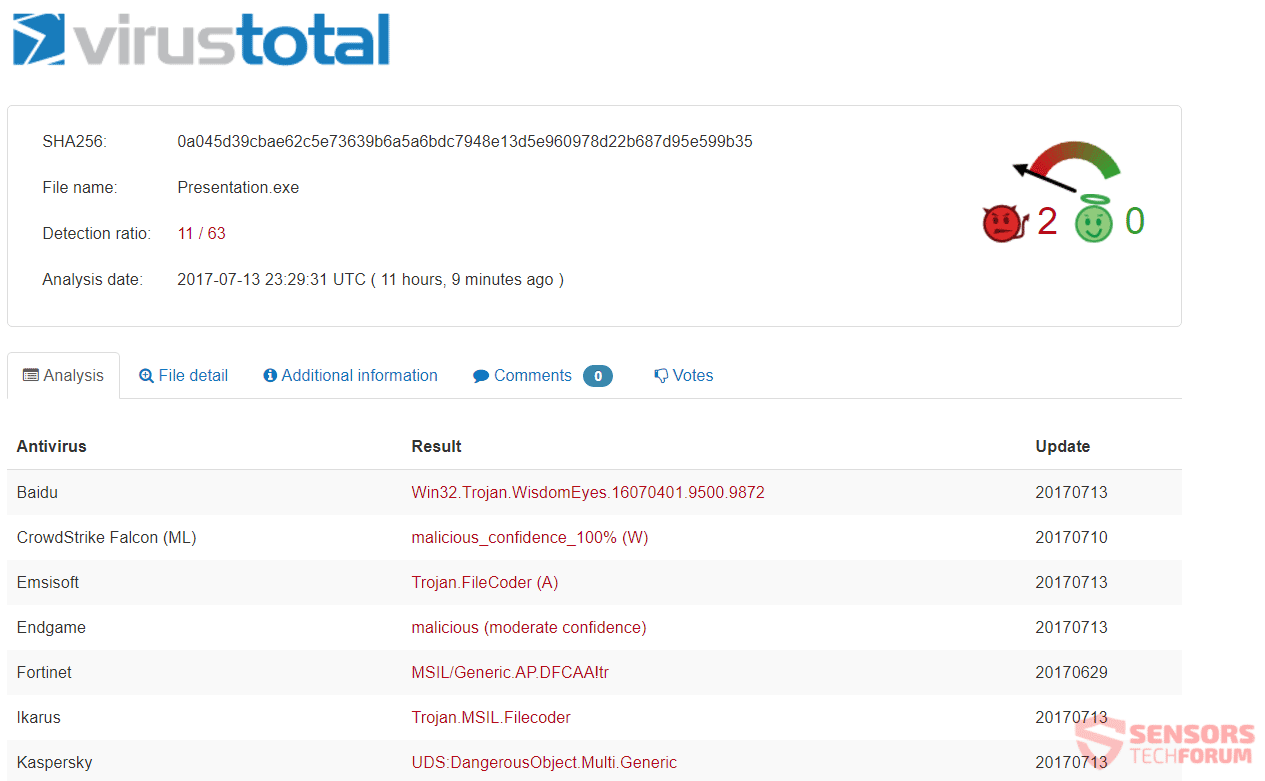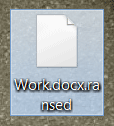The article will help you remove Ransed ransomware efficiently. Follow the ransomware removal instructions at the end of the article.
Ransed is the name of a ransomware cryptovirus which is found recently. The ransomware connects to a remote MySQL database for storing the data of victims. The virus is coded to place the extension .ransed after encryption to all locked files. The Ransed virus displays a ransom note with instructions for payment, which mainly consist of how to pay 25 US dollars in the Bitcoin currency to allegedly restore your files. Continue on reading down below to see how you could try to potentially recover some of your data.

Threat Summary
| Name | Ransed |
| Type | Ransomware |
| Short Description | The ransomware encrypts files on your computer and displays a ransom message afterward. |
| Symptoms | The ransomware will encrypt your files and put the extension .ransed to them after it finishes its encryption process. |
| Distribution Method | Spam Emails, Email Attachments |
| Detection Tool |
See If Your System Has Been Affected by malware
Download
Malware Removal Tool
|
User Experience | Join Our Forum to Discuss Ransed. |
| Data Recovery Tool | Windows Data Recovery by Stellar Phoenix Notice! This product scans your drive sectors to recover lost files and it may not recover 100% of the encrypted files, but only few of them, depending on the situation and whether or not you have reformatted your drive. |

Ransed Ransomware – Infection
Ransed ransomware could spread its infection with various methods. A payload dropper which initiates the malicious script for this ransomware is being spread around the World Wide Web, and researchers have gotten their hands on a malware sample. If that file lands on your computer system and you somehow execute it – your computer will become infected. You can see the detections of such a file on the VirusTotal service right here:
Ransed ransomware might also distribute its payload file on social media and file-sharing services. Freeware which is found on the Web can be presented as helpful also be hiding the malicious script for the cryptovirus. Refrain from opening files right after you have downloaded them. You should first scan them with a security tool, while also checking their size and signatures for anything that seems out of the ordinary. You should read the tips for preventing ransomware found in our forum section.

Ransed Ransomware – Details
Ransed is a virus that could encrypt your files and extort you to pay a ransom to get them back to normal. It displays a rather detailed ransom note with instructions. You are threatened that you have 7 days to pay up the ransom or your files will be gone.
Ransed ransomware might make entries in the Windows Registry to achieve persistence, and could launch or repress processes in a Windows environment. Such entries are typically designed in a way to launch the virus automatically with each start of the Windows operating system.
In the below screenshot you could see the ransom note:
That ransom note reads the following:
Imfao u just got rekt by RANSED
it’d be a shame if i encrypted your files…
aaand it’s done.
u might be worried and so do I.
if u no pay say goodbye to ur files
rip u m8
Iol w8 u can recover ur files
it will cost u 25 dollars :)
btw u pay with BITCOIN k?
head over to that thing —–>
and go to the ‘Unlock’ tab
gg ez
Time left: 06D 23H 59M 59Swut is bitcoin | how can I get bitcons | Unlock l Contact us
u dont know what is bitcoin? rly?
Bitcoin is a form of digital currency, created and held
electronically. No one controls it. Bitcoins aren’t
printed, like dollars or euros – they’re produced by
people, and increasingly businesses, running computers
all around the world, using software that solves
mathematical problems.
It’s fhe first example of a growing category of money
known as cryptocurrency.
What makes if different from normal currencies?
Bitcoin can be used to buy things electronically. In
that sense, its like conventional dollars, euros, or yen,
which are also traded digitally.
However, bitcoin‘s most important characteristic, and…
When you click on the tab “how can I get bitcoins” it states the following:
Surprisingly, it’s still not easy to buy bitcoins with
your credit card or PayPal, depending on your
jurisdiction.This is because such transactions can easily be
reversed with a phone call to the card company (ie
‘chargebacks’). Since it’s hard to prove any goods
changed hands in a transfer of bitcoins, exchanges
avoid this payment method and so do most private
sellers.However, the options have recently grown for
consumers in some countries.In the US, Coinbase, and Circle offer purchases with
credit cards. Bittylicious, CoinCorner and Coinbase
offer this service in the UK, accepting 3D Secure-
enabled credit and debit cards on the Visa and
MasterCard networks.
The note of the Ransed ransomware states that your files are encrypted. The ransom sum of 25 US dollars is demanded as payment for potentially unlocking your files. However, if you are asked to pay a ransom you should NOT under any circumstances pay any ransom. Your files may not get restored, and nobody could guarantee that. Moreover, giving money to cybercriminals will likely motivate them to create more ransomware viruses.

Ransed Ransomware – Encryption
Ransed ransomware seeks to encrypt files with the following extensions:
→.doc, .docx, .xls, .xlsx, .jpg, .png, .txt, .ppt, .pptx
Every single file that gets encrypted will receive the same extension appended to it, which is .ransed. The encryption algorithm which is implemented is unknown but the MySQL credentials for accessing your data are contained in the executable file of the ransomware.
The Ransed cryptovirus could be set to erase all the Shadow Volume Copies from the Windows operating system with the help of the following command:
→vssadmin.exe delete shadows /all /Quiet
In case the command stated above is executed that would make the encryption process more efficient as it will eliminate one of the ways for restoring your data. If your computer device was infected with this ransomware and your files are locked, read on through to find out how you could potentially recover your files.

Remove Ransed Ransomware and Restore .Ransed Files
If your computer got infected with the Ransed ransomware virus, you should have a bit of experience in removing malware. You should get rid of this ransomware as quickly as possible before it can have the chance to spread further and infect other computers. You should remove the ransomware and follow the step-by-step instructions guide provided below.
- Step 1
- Step 2
- Step 3
- Step 4
- Step 5
Step 1: Scan for Ransed with SpyHunter Anti-Malware Tool



Ransomware Automatic Removal - Video Guide
Step 2: Uninstall Ransed and related malware from Windows
Here is a method in few easy steps that should be able to uninstall most programs. No matter if you are using Windows 10, 8, 7, Vista or XP, those steps will get the job done. Dragging the program or its folder to the recycle bin can be a very bad decision. If you do that, bits and pieces of the program are left behind, and that can lead to unstable work of your PC, errors with the file type associations and other unpleasant activities. The proper way to get a program off your computer is to Uninstall it. To do that:


 Follow the instructions above and you will successfully delete most unwanted and malicious programs.
Follow the instructions above and you will successfully delete most unwanted and malicious programs.
Step 3: Clean any registries, created by Ransed on your computer.
The usually targeted registries of Windows machines are the following:
- HKEY_LOCAL_MACHINE\Software\Microsoft\Windows\CurrentVersion\Run
- HKEY_CURRENT_USER\Software\Microsoft\Windows\CurrentVersion\Run
- HKEY_LOCAL_MACHINE\Software\Microsoft\Windows\CurrentVersion\RunOnce
- HKEY_CURRENT_USER\Software\Microsoft\Windows\CurrentVersion\RunOnce
You can access them by opening the Windows registry editor and deleting any values, created by Ransed there. This can happen by following the steps underneath:


 Tip: To find a virus-created value, you can right-click on it and click "Modify" to see which file it is set to run. If this is the virus file location, remove the value.
Tip: To find a virus-created value, you can right-click on it and click "Modify" to see which file it is set to run. If this is the virus file location, remove the value.
Before starting "Step 4", please boot back into Normal mode, in case you are currently in Safe Mode.
This will enable you to install and use SpyHunter 5 successfully.
Step 4: Boot Your PC In Safe Mode to isolate and remove Ransed





Step 5: Try to Restore Files Encrypted by Ransed.
Method 1: Use STOP Decrypter by Emsisoft.
Not all variants of this ransomware can be decrypted for free, but we have added the decryptor used by researchers that is often updated with the variants which become eventually decrypted. You can try and decrypt your files using the instructions below, but if they do not work, then unfortunately your variant of the ransomware virus is not decryptable.
Follow the instructions below to use the Emsisoft decrypter and decrypt your files for free. You can download the Emsisoft decryption tool linked here and then follow the steps provided below:
1 Right-click on the decrypter and click on Run as Administrator as shown below:

2. Agree with the license terms:

3. Click on "Add Folder" and then add the folders where you want files decrypted as shown underneath:

4. Click on "Decrypt" and wait for your files to be decoded.

Note: Credit for the decryptor goes to Emsisoft researchers who have made the breakthrough with this virus.
Method 2: Use data recovery software
Ransomware infections and Ransed aim to encrypt your files using an encryption algorithm which may be very difficult to decrypt. This is why we have suggested a data recovery method that may help you go around direct decryption and try to restore your files. Bear in mind that this method may not be 100% effective but may also help you a little or a lot in different situations.
Simply click on the link and on the website menus on the top, choose Data Recovery - Data Recovery Wizard for Windows or Mac (depending on your OS), and then download and run the tool.
Ransed-FAQ
What is Ransed Ransomware?
Ransed is a ransomware infection - the malicious software that enters your computer silently and blocks either access to the computer itself or encrypt your files.
Many ransomware viruses use sophisticated encryption algorithms to make your files inaccessible. The goal of ransomware infections is to demand that you pay a ransom payment to get access to your files back.
What Does Ransed Ransomware Do?
Ransomware in general is a malicious software that is designed to block access to your computer or files until a ransom is paid.
Ransomware viruses can also damage your system, corrupt data and delete files, resulting in the permanent loss of important files.
How Does Ransed Infect?
Via several ways.Ransed Ransomware infects computers by being sent via phishing emails, containing virus attachment. This attachment is usually masked as an important document, like an invoice, bank document or even a plane ticket and it looks very convincing to users.
Another way you may become a victim of Ransed is if you download a fake installer, crack or patch from a low reputation website or if you click on a virus link. Many users report getting a ransomware infection by downloading torrents.
How to Open .Ransed files?
You can't without a decryptor. At this point, the .Ransed files are encrypted. You can only open them once they are decrypted using a specific decryption key for the particular algorithm.
What to Do If a Decryptor Does Not Work?
Do not panic, and backup the files. If a decryptor did not decrypt your .Ransed files successfully, then do not despair, because this virus is still new.
Can I Restore ".Ransed" Files?
Yes, sometimes files can be restored. We have suggested several file recovery methods that could work if you want to restore .Ransed files.
These methods are in no way 100% guaranteed that you will be able to get your files back. But if you have a backup, your chances of success are much greater.
How To Get Rid of Ransed Virus?
The safest way and the most efficient one for the removal of this ransomware infection is the use a professional anti-malware program.
It will scan for and locate Ransed ransomware and then remove it without causing any additional harm to your important .Ransed files.
Can I Report Ransomware to Authorities?
In case your computer got infected with a ransomware infection, you can report it to the local Police departments. It can help authorities worldwide track and determine the perpetrators behind the virus that has infected your computer.
Below, we have prepared a list with government websites, where you can file a report in case you are a victim of a cybercrime:
Cyber-security authorities, responsible for handling ransomware attack reports in different regions all over the world:
Germany - Offizielles Portal der deutschen Polizei
United States - IC3 Internet Crime Complaint Centre
United Kingdom - Action Fraud Police
France - Ministère de l'Intérieur
Italy - Polizia Di Stato
Spain - Policía Nacional
Netherlands - Politie
Poland - Policja
Portugal - Polícia Judiciária
Greece - Cyber Crime Unit (Hellenic Police)
India - Mumbai Police - CyberCrime Investigation Cell
Australia - Australian High Tech Crime Center
Reports may be responded to in different timeframes, depending on your local authorities.
Can You Stop Ransomware from Encrypting Your Files?
Yes, you can prevent ransomware. The best way to do this is to ensure your computer system is updated with the latest security patches, use a reputable anti-malware program and firewall, backup your important files frequently, and avoid clicking on malicious links or downloading unknown files.
Can Ransed Ransomware Steal Your Data?
Yes, in most cases ransomware will steal your information. It is a form of malware that steals data from a user's computer, encrypts it, and then demands a ransom in order to decrypt it.
In many cases, the malware authors or attackers will threaten to delete the data or publish it online unless the ransom is paid.
Can Ransomware Infect WiFi?
Yes, ransomware can infect WiFi networks, as malicious actors can use it to gain control of the network, steal confidential data, and lock out users. If a ransomware attack is successful, it could lead to a loss of service and/or data, and in some cases, financial losses.
Should I Pay Ransomware?
No, you should not pay ransomware extortionists. Paying them only encourages criminals and does not guarantee that the files or data will be restored. The better approach is to have a secure backup of important data and be vigilant about security in the first place.
What Happens If I Don't Pay Ransom?
If you don't pay the ransom, the hackers may still have access to your computer, data, or files and may continue to threaten to expose or delete them, or even use them to commit cybercrimes. In some cases, they may even continue to demand additional ransom payments.
Can a Ransomware Attack Be Detected?
Yes, ransomware can be detected. Anti-malware software and other advanced security tools can detect ransomware and alert the user when it is present on a machine.
It is important to stay up-to-date on the latest security measures and to keep security software updated to ensure ransomware can be detected and prevented.
Do Ransomware Criminals Get Caught?
Yes, ransomware criminals do get caught. Law enforcement agencies, such as the FBI, Interpol and others have been successful in tracking down and prosecuting ransomware criminals in the US and other countries. As ransomware threats continue to increase, so does the enforcement activity.
About the Ransed Research
The content we publish on SensorsTechForum.com, this Ransed how-to removal guide included, is the outcome of extensive research, hard work and our team’s devotion to help you remove the specific malware and restore your encrypted files.
How did we conduct the research on this ransomware?
Our research is based on an independent investigation. We are in contact with independent security researchers, and as such, we receive daily updates on the latest malware and ransomware definitions.
Furthermore, the research behind the Ransed ransomware threat is backed with VirusTotal and the NoMoreRansom project.
To better understand the ransomware threat, please refer to the following articles which provide knowledgeable details.
As a site that has been dedicated to providing free removal instructions for ransomware and malware since 2014, SensorsTechForum’s recommendation is to only pay attention to trustworthy sources.
How to recognize trustworthy sources:
- Always check "About Us" web page.
- Profile of the content creator.
- Make sure that real people are behind the site and not fake names and profiles.
- Verify Facebook, LinkedIn and Twitter personal profiles.




